Application Pool
This is one of the most important things you should create for your applications in a production environment. Application pools are used to separate sets of IIS worker processes that share the same configuration. Application pools enable us to isolate our web application for better security, reliability, and availability. The worker process serves as the process boundary that separates each application pool so that when one worker process or application has an issue or is recycled, other applications or worker processes are not affected.
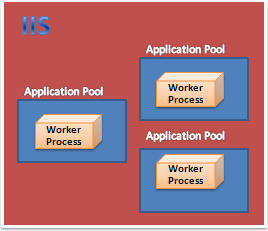
Identity of Application Pool
Application pool identity configuration is an important aspect of security in IIS 6.0 and IIS 7.0, because it determines the identity of the worker process when the process is accessing a resource. In IIS 7.0, there are three predefined identities that are the same as in IIS 6.0.
| Application Pool Identity | Description |
LocalSystem | Built-in account that has administrative privileges on the server. It can access both local and remote resources. For any kind accessing of server files or resources, we have to set the identity of the application pool to LocalSystem. |
LocalServices | Built-in account has privileges of an authenticated local user account. It does not have any network access permission. |
NetworkServices | This is the default identity of Application Pool. NetworkServices has the privileges of an authenticated local user account. |
Creating and assigning Application Pool
Open IIS Console, right click on Application Pool Folder > Create New.

Give the Application Pool ID and click OK.
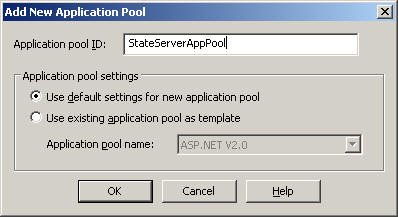
Now, right click on the Virtual Directory (I am using StateServer web sites) and assign
StateServerAppPool to the StateServer Virtual Directory.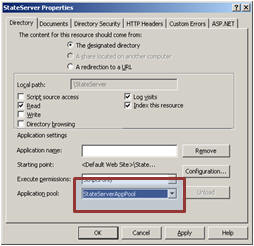
So this StateServer web site will run independently with
StateServerAppPool. Any problem related with other applications will not affect this application. This is the main advantage of creating application pools separately.Web Farm
This is the case where you have only one web server and multiple clients requesting for resources from the same server. But when are is huge amount of incoming traffic for your web sites, one standalone server is not sufficient to process the request. You may need to use multiple servers to host the application and divide the traffic among them. This is called “Web Farm”. So when you are hosting your single web site on multiple web servers over load balancer is called “Web Farm”. The below diagram shows the overall representation of Web Farms.
In general web farm architecture, a single application is hosted on multiple IIS Server and those are connected with the VIP (Virtual IP) with Load Balancer. Load Balancer IPs are exposed to external world to access. So whenever some request will come to server from clients, it will first hit the Load Balancer, then based on the traffic on each server, LB distributes the request to the corresponding web server. These web servers may share the same DB server or may be they can use a replicated server in the back end.
So, in a single statement, when we host a web application over multiple web servers to distribute the load among them, it is called Web Farm.
Web Garden
By default, each application pool runs with a single worker process (W3Wp.exe). We can assign multiple worker processes with a single application pool. An application pool with multiple worker processes is called a Web Garden. Many worker processes with the same Application Pool can sometimes provide better throughput performance and application response time. And each worker process should have its own Thread and memory space.
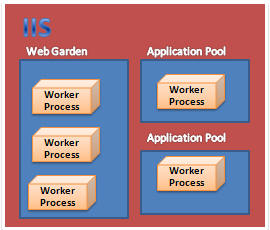
As shown in the picture, in IIS, there may be multiple application pools and each application pool will have at least one worker process. A Web Garden should contain multiple worker processes.
There are certain restrictions in using a Web Garden with your web application. If we use the InProc session mode, our application will not work correctly because the session will be handled by a different worker process. To avoid this problem, we should use the OutProc session mode and we can use a session state server or SQL-Server session state.
Main advantage: The worker processes in a Web Garden share the requests that arrive for that particular application pool. If a worker process fails, another worker process can continue processing the requests.
How to Create a Web Garden?
Right click on Application Pool > Go to Performance tab > Check Web Garden section (highlighted in picture):
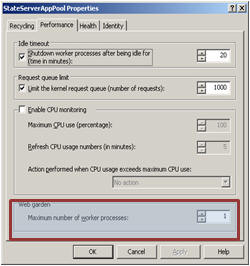
By default, it would be 1. Just change it to more than one.
How Session depends on Web Garden?
InProc is handled by a worker process. It keeps data inside its memory object. Now if we have multiple worker processes, then it would be very difficult to handle the session because each and every worker process has its own memory, so if my first request goes to WP1 and it keeps my session data and the second request goes to WP2, I am trying to retrieve session data and it will not be available, which will throw an error. So please avoid Web Gardens in InProc session mode.
We can use StateServer or SQLServer session modes in Web Gardens because as I have already explained, these two session modes do not depend on worker processes. In my example, I have also explained that if you restart IIS, you are still able to access your session data.
Ref By-
www.codeproject.com/Articles/32545/Exploring-Session-in-ASP-Net
http://www.codeproject.com/Articles/114910/What-is-the-difference-between-Web-Farm-and-Web-Ga
www.codeproject.com/Articles/32545/Exploring-Session-in-ASP-Net
http://www.codeproject.com/Articles/114910/What-is-the-difference-between-Web-Farm-and-Web-Ga
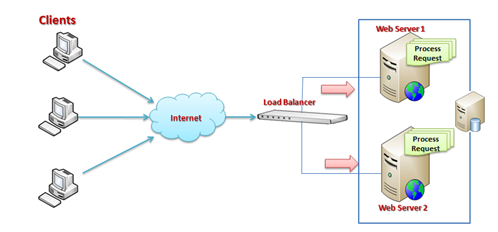
No comments:
Post a Comment